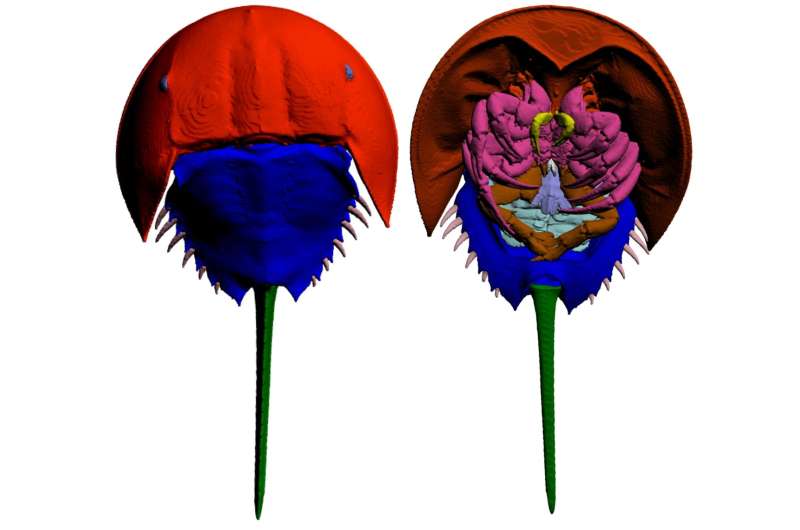CT scans reveal new muscles in horseshoe crab appendages

Digital dissection shows that two horseshoe crab appendages—the pushing leg and the male pedipalp—each have one more muscle than had been thought, according to a study published February 14, 2018 in the open-access journal PLOS ONE by Russell Bicknell from University of New England, Australia, and colleagues.
The horseshoe crab, Limulus polyphemus, has unique anatomical features and an ancient lineage, making this iconic chelicerate one of the most well documented arthropods. However, as is true of most invertebrates, Limulus' features are regularly depicted in two dimensions.
Bicknell and colleagues did computed tomography, or CT scans, of a dried horseshoe crab carcass from the University of New England Natural History Museum as well as of fresh appendages, and then used the scans to develop 3D models of the muscles in their appendages. The researchers focused on the cephalothorax—or semicircular frontal section—which has seven pairs of appendages. The appendages that attached to the ventral side are used to move and eat.
The researchers identified two new muscles in horseshoe crab appendages, one in the pushing leg and the other in the male pedipalp. Knowing the muscles of this archetypal chelicerate could help researchers understand those of extinct taxa and suggest functional limits to their feeding ability and to the motion of their appendages. Such 3D documentation of horseshoe crabs and other iconic and rare taxa supplements physical examination of specimens, and is a step towards creating a digital record of life on Earth.
"We have studied and scanned Limulus polyphemus as it is an iconic, yet strangely alien organism," says Bicknell. "It almost looks as if it was plucked right out of the age of dinosaurs! We therefore thought that it needed and deserved to be recorded in 3D."
More information: Bicknell RDC, Klinkhamer AJ, Flavel RJ, Wroe S, Paterson JR (2018) A 3D anatomical atlas of appendage musculature in the chelicerate arthropod Limulus polyphemus. PLoS ONE 13(2): e0191400.
Journal information: PLoS ONE
Provided by Public Library of Science




















